Red hot mama.
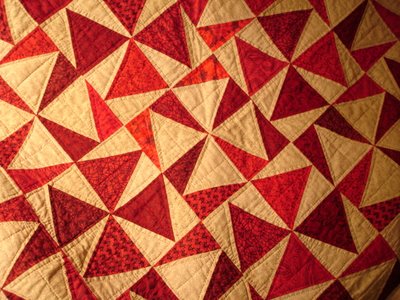
My mother and I traveled to Boston's Museum of Fine Arts last summer to see an exhibit of quilts from Gee's Bend, Alabama. The Gee's Bend quilts had shown at the Whitney in New York City in winter 2002-03 and had been on the road pretty much ever since, as far as I knew. We managed to make it to the show on the day of a gallery talk, and so we visited the quilts twice: once in the morning, just after the museum opened, when we knew we'd have ample time to wander around, separately and together, examining the stitching and the patterns close-up and from afar. After our first couple hours of looking, we headed down the road to the Isabella Stuart Gardner Museum (a story for another night), but we went back to hear the docent's talk.
Not surprisingly, the talk was packed. Having done some docent work, my heart sank for our poor speaker, who had to find a way to move sixty people through galleries and still be heard. Her strategy, logically, was simply to park us in front of a few pieces and talk from there. Midway through her first quilt, the docent asked for questions, and a woman in the front row started trying to assert some kind of authority by talking about having met the quilters when they traveled up from Alabama for the show's opening. She praised them for having really had a sense of themselves as artists, not just as women who happened to have made quilts. And just when things started sounding as though they were going to get really condescending--these simple women from Alabama somehow became great, if somewhat unconventional, American artists! almost despite themselves!--my mother raised her hand.
For a split second, I feared that my mother was going to decimate this other woman verbally. Instead, when the docent called on her, my mother turned the conversation back to the art object on the wall. "Can you show us the back of the quilt?" she asked. Alas, it turned out that the docent had not been trained or equipped with white gloves for such interaction with the quilt. But I was so glad that my mother had turned the conversation back from a direction which seemed to suggest that the quilts' artistry or the quilters' intentionality might be questionable; with her question, she accorded both the respect of a fellow artist recognizing good work well done, and she implicitly instructed our tourmates about how to approach quilts as art. And she managed to do it without belittling anyone. My mother is like that; she's a teacher, after all, in all the truest senses of the word.
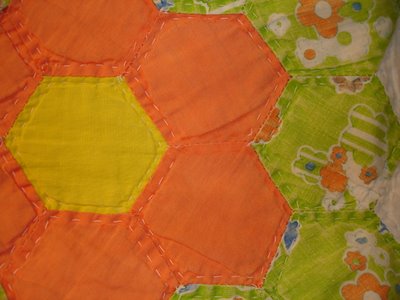
I have a long apprenticeship to quilting as an art, even though I have accepted that I myself will never be a quilter. My mother took up quilting when I was a baby; my first memories of her quilting are from the Christmas after my brother was born, when she was putting the yellow binding on the grandmother's flower garden quilt she made first. It wasn't an easy quilt to start with: grandmother's flower garden is a simple pattern, but it's a simple pattern made up of hexagons. Being that she made it in 1979, it's unsurprising to me that my mother chose the bright colors she did--lime, turquoise, gold, orange, red, all tied together with repetitions of bright white and bright yellow. Over the past few months, I've been giving a great deal of thought to the roots of my aesthetic values, and I have figured out (it was a duh! moment when it hit me, I'll tell you) that my mother's quilts have been perhaps my most important influence.
It's a particularly funny realization because I designed one of my master's exams to figure out why I am so enamored of novels in pieces--the great big nineteenth-century novels, heirs to the epistolary novel tradition, that show off their seams, their constructions out of letters, diaries, transcriptions, multiple narrators' testimonies, reflections on the past and tales of the present. I didn't get much of anywhere (though the question focused me in just the right way to see what I see in my research work). But I'm pretty sure that my having grown up surrounded by piles of fabric in various stages of being patterned--soft shards of cottons and tall stacks of blocks and fat folds of quilt-tops and hoops and frames of quilts-in-progress--might have had something to do with this fondness.
Now, one thing you learn when you're the attentive daughter of an active quilter is that the front of a quilt only tells half that quilt's story or presents half its artistry (if even that). To know what's happening on a quilt, to apprehend its patterns fully, to understand how its artist (or artists) pulled all its elements together, you have to look at the back of the quilt, as well. Hence my mother's question to the MFA docent. Hence our disappointment when she couldn't actually turn the corner back. And hence the MFA's decision to hang at least a few of the quilts in special frames that allowed visitors to examine them from both sides, which was some consolation.
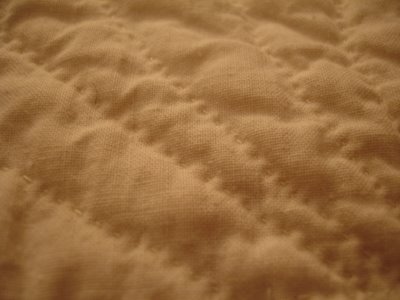
In my house, quilts have never been just about being showy, and they have never been just about being useful. Indeed, my mother's quilts are the quintessence of useful beauty. If I take into account all the times I've slept under them, lain on couches under them, and wrapped up in them in sickness and in health, I'd have to guess that I've spent well over half the days of my life being warmed by her work, generally by more than one of her quilts at a time. (There are four on this couch right now--but that's chiefly because I brought three of them downstairs for photographs, earlier. Those three will go back upstairs with me in a little while, and then I'll have five quilts on my bed again. And these are only the full-size quilts; I haven't counted up the smaller quilted hangings and runners scattered through the house.)
Growing up literally surrounded by quilts, I learned to love the quieter signs of patient labor and creative work. I learned to love tracing geometrical shapes, finding the places where patterns seemed to turn on their heads, to become altogether other than what they'd just been, places where a square resolves into two triangles or two triangles become a diamond. The front of a pieced quilt will show off its shapes more or less kaleidoscopically, depending on the nature of its patterns. But the back of such a quilt will reflect or refract or subvert or echo or utterly undo those shapes, all according to the designs of the quilter. My mother has taken tops made up of neat geometric structures and quilted them with Baptist fans, the name for a style of quilting wherein a person stitches concentric curves as far as the arm can reach before choosing a new center and starting again. The effect is a tension of curves and corners, lines radiating in semi-circles and demarcating squares, rectangles, triangles, diamonds.
When my mother started machine-quilting about a decade ago, I was not as supportive as I might have been. Her hand-quilting is tiny and lovely, and the earliest machine-quilted pieces were rough in a way that her hand-quilted ones hadn't been for years. But like any adventuresome artist, my mother kept experimenting with her medium despite my naysaying and now produces beautiful machine-quilted work as well.
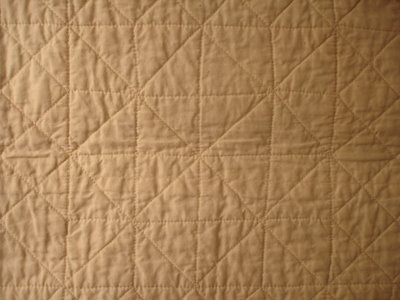
It has always been easy for me to get lost in quilts; they are excellent resting places for a tired imagination, their regularities so fertile, their oddities so suggestive of lore and locale. Talking quilts with my mother also crafted a whole realm of my intellectual abilities: some of my earliest and richest conversations about color and design and arrangement--about taste, in short--were conversations about quilts, about how my mother's and my palettes differ, or about where particular blocks looked best, or about what kinds of innovations really worked and which didn't. Over the years, I have developed a massive fondness both for crazy quilts and for very regularly repetitive patterns of tiny pieces--complex double wedding rings, intricate star quilts, huge and deceptively simple nine patches. I can marvel at Baltimore album quilts but have never felt much of a desire to own one.

I'm also a fan of mavericks--quilts that take off from an established pattern, turning a well-known block into something unexpected or defiant or rebellious. During our Boston trip last summer, we ventured to the New England Quilt Museum in Lowell, Massachusetts, where we found a whole exhibit of mavericks from the past two centuries. Maverick quilts are my favorite sign of just how much experimentation and serious fun and sheer artistry was always involved in quilting, well before the Art Quilt movement (sort of the modernist movement for quilting) really got underway in the late twentieth century. (My parallels and analogies are tiring, as I tire.)
As we wandered through the NEQM's galleries, my mom and I kept doing our best to peer behind the quilts on display, to see what the stitch-flourishes looked like in different proximity to the quilt tops' surprises of pattern and color. It's because of my mother that I know to be curious about such things. It's because of her quilting that I know how to think about a big picture and a tiny detail at the same moment, and how to piece a series of tiniest details together patiently, patiently, knowing that a grander vision is emerging, long before it's visible--and how (and why) to keep lavishing care on that vision, long after it's become visible and has perhaps seemed to be almost fully realized, almost finished. And so it's through her quilts that I'm saying happy mother's day this year. I love your quilts, Mama, and I love you too.
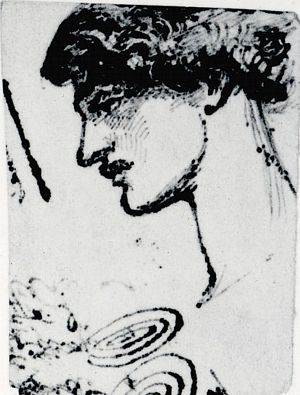

8 Comments:
Thank you, dear Doctor Daughter. I am so blessed to be the mother of people who add more to my life each day!
Oh my gosh, what an awesome essay. So much more than "here are some pretty quilts." I'm so glad that I stumbled across this site.
Thanks, DrS.
I became a quilter in my graduate program when I was invited to join the quilt circle made up of PhD students in a loose constellation of degree programs. Your appreciation of quilting process is validating and inspiring. Even more it's so nice to hear someone address what I & the women I quilted with at my PhD school all knew: quilting is very much like writing. It's hard in exactly the same ways...
I'm somehow surprised you're not a quilter. But you make pie. I can accept that...
Hey, StinkyLulu--
I actually had a great conversation with someone here about a week ago, and talking about how I came to make pies (in graduate school!) helped me clarify that I make them in just the same way, and for just the same reasons, that my mother quilts. (My mother's response when I shared this epiphany: "I could have told you that years ago.") There's a faster turnaround time for pies, of course, and I suspect that's part of the reason I love them. My long patience all goes into my writing.
this is so awesome and so lovely and so personally evocative. thank you, and happy mother's day!
Look carefully . . . Grandmother's Flower Garden is constructed from hexagons, not octagons. The shape is based on 60 degree triangles, which makes them more difficult to assemble, necessitating the use of "Y" seams, which is why most are hand pieced, not assembled on the machine. That fact makes it all the more astounding that a 20th century pattern became so popular.
Ah, it's always good to get called on one's geometry. I did do quite well in math before I threw it over for the PhD in literature. Corrections have been made!
So well written, and lovely quilts, too. I'm always in a tension between art and utility about quilts. Well said.
Post a Comment
<< Home